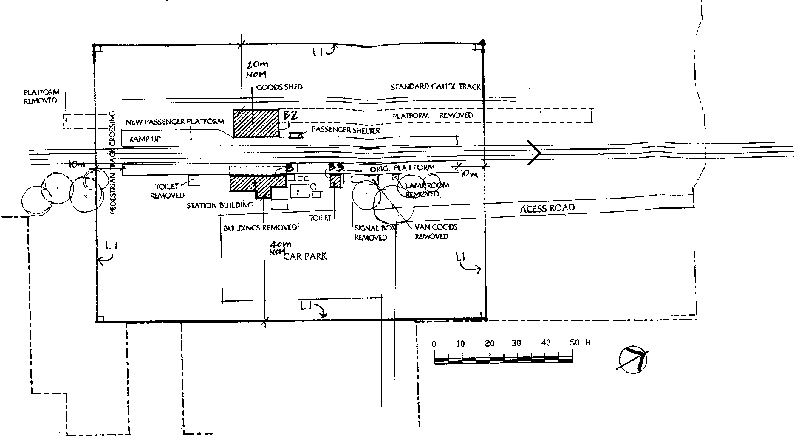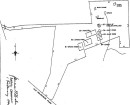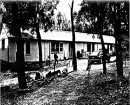Back to search results
LITTLE RIVER RAILWAY STATION AND GOODS YARD
19-27 RIVER STREET LITTLE RIVER, WYNDHAM CITY
LITTLE RIVER RAILWAY STATION AND GOODS YARD
19-27 RIVER STREET LITTLE RIVER, WYNDHAM CITY
All information on this page is maintained by Heritage Victoria.
Click below for their website and contact details.
Victorian Heritage Register
-
Add to tour
You must log in to do that.
-
Share
-
Shortlist place
You must log in to do that.
- Download report

LITTLE RIVER RAILWAY STATION AND GOODS YARD SOHE 2008






On this page:
Statement of Significance
What is significant?
The Little River Station and Goods Shed was built in 1864 by SamuelAmess on the Geelong-Melbourne line, for the Victorian Railwaysarchitects. It comprises a basalt station building, asymmetricallycomposed, with decorated bargeboard to the gables and a decorativetimber platform verandah. Other structures include a basalt lamproom/toilet block and a rusticated goods shed featuring a trabeateddecorative system, pedimented gables and rum through. Several featuresof note include the basement holding cells and the Victorian Railwaysplaques to the end of the gables. The former signal box, van goods shedand toilet block have been removed. While the station platform is stillin use, the station buildings are currently closed.
How is it significant?
The Little River Railway Station is historically and architecturallysignificant to the State of Victoria.
Why is it significant?
Little River Railway Station and Goods Shed are historically significantas a rare example of buildings erected during the initial phase ofrailway building in the colony. Constructed in 1864 of a unique design,the Little River Railway Station was one of the earliest stationbuildings to be built in Victoria. Built during the period of the 'maintrunk lines', c.1857 - c.1869, the formative years of railwaydevelopment in Victoria.
Little River Railway Station is architecturally significant for itsplanning, design and detailing, and is a notable example of a countryrailway station. The goods shed is architecturally significant as a rareexample of its type.
The Little River Station and Goods Shed was built in 1864 by SamuelAmess on the Geelong-Melbourne line, for the Victorian Railwaysarchitects. It comprises a basalt station building, asymmetricallycomposed, with decorated bargeboard to the gables and a decorativetimber platform verandah. Other structures include a basalt lamproom/toilet block and a rusticated goods shed featuring a trabeateddecorative system, pedimented gables and rum through. Several featuresof note include the basement holding cells and the Victorian Railwaysplaques to the end of the gables. The former signal box, van goods shedand toilet block have been removed. While the station platform is stillin use, the station buildings are currently closed.
How is it significant?
The Little River Railway Station is historically and architecturallysignificant to the State of Victoria.
Why is it significant?
Little River Railway Station and Goods Shed are historically significantas a rare example of buildings erected during the initial phase ofrailway building in the colony. Constructed in 1864 of a unique design,the Little River Railway Station was one of the earliest stationbuildings to be built in Victoria. Built during the period of the 'maintrunk lines', c.1857 - c.1869, the formative years of railwaydevelopment in Victoria.
Little River Railway Station is architecturally significant for itsplanning, design and detailing, and is a notable example of a countryrailway station. The goods shed is architecturally significant as a rareexample of its type.
Show more
Show less
-
-
LITTLE RIVER RAILWAY STATION AND GOODS YARD - History
Little River Railway Station and Goods Shed are the only surviving example of buildings erected during the initial phase of railway building in the colony outside of the Williamstown, Echuca and Geelong to Ballarat trunk lines. Constructed in 1864 of a unique design, the Little River Railway Station was one of the earliest station buildings to be built in Victoria, built during the period of the 'main trunk lines', c.1857 - c.1869. These were the formative years of railway development in Victoria. This period of construction was characterised by lavish expenditure on railway structures, designed in accordance with the British standards of the time. (Harrigan, 1962) (Beeston, 1995)LITTLE RIVER RAILWAY STATION AND GOODS YARD - Permit Exemptions
General Exemptions:General exemptions apply to all places and objects included in the Victorian Heritage Register (VHR). General exemptions have been designed to allow everyday activities, maintenance and changes to your property, which don’t harm its cultural heritage significance, to proceed without the need to obtain approvals under the Heritage Act 2017.Places of worship: In some circumstances, you can alter a place of worship to accommodate religious practices without a permit, but you must notify the Executive Director of Heritage Victoria before you start the works or activities at least 20 business days before the works or activities are to commence.Subdivision/consolidation: Permit exemptions exist for some subdivisions and consolidations. If the subdivision or consolidation is in accordance with a planning permit granted under Part 4 of the Planning and Environment Act 1987 and the application for the planning permit was referred to the Executive Director of Heritage Victoria as a determining referral authority, a permit is not required.Specific exemptions may also apply to your registered place or object. If applicable, these are listed below. Specific exemptions are tailored to the conservation and management needs of an individual registered place or object and set out works and activities that are exempt from the requirements of a permit. Specific exemptions prevail if they conflict with general exemptions. Find out more about heritage permit exemptions here.Specific Exemptions:General Conditions
1. All alterations are to be planned and carried out in a manner that prevents damage to the fabric of the registered place or object.
2. Should it become apparent during further inspection or the carrying out of alterations that original or previously hidden or inaccessible details of the place or object are revealed which relate to the significance of the place or object, then the exemption covering such alteration shall cease and the Executive Director shall be notified as soon as possible.
3. If there is a conservation policy and plan approved by the Executive Director, all works shall be in accordance with it.
4. Nothing in this declaration prevents the Executive Director from amending or rescinding all or any of the permit exemptions.
5. Nothing in this declaration exempts the owners or their agents from the responsibility to seek relevant planning or building permits from the responsible authority where applicable.
* All basic refurbishment works including repairs to buildings and structures, where works are documented and administered by a recognised conservation consultant.
* Installation of perimeter fencing.
* Modification and replacement of tracks to the extent of the rails, sleepers and ballast.
* Installation of new landscaping features but excluding earthworks where more than 1m3 of ground is to be altered.
Station Buildings
Exterior
*Replacement of decayed fabric with fabric that matches the original design and profile.
* Installation of new but not removal of existing original significant signage.
* Installation of temporary protective hoardings, screens and the like for the protection against intrusion of vandals and the like provided that no damage is sustained to significant fabric.
* Installation of new damp proofing and making good to match existing, adjacent surfaces.
Interior
* Interior painting but not stripping of existing paint scheme.
* Installation of new but not removal of existing original significant carpets/flexible floor coverings.
* Installation of new but not removal of existing original significant fixtures and fittings, including clocks, soft furnishings including curtain tracks, rods, blinds and other window dressings, and the like.
* Installation of new but not the removal of existing original significant signage.
* Installation of new partitions provided that no damage is sustained to significant fabric.
* Replacement of non-original kitchen and toilet fixtures provided that no damage is sustained to significant fabric.
* Installation of insulation to ceiling spaces.
* Installation of hooks, nails and other devices for the hanging of paintings, mirrors and other wall mounted works of art.
* Goods shed interior platform.LITTLE RIVER RAILWAY STATION AND GOODS YARD - Permit Exemption Policy
The purpose of the permit exemptions is to allow works that do not impact on the significance of the place to occur without the need for a permit. The Little River Railway Station and Goods Yard is important for its individual buildings and structures as well as its precinct values. The exterior of the buildings are of prime importance as is the relationship between the structures. The interiors are important if original fittings and fixtures still survive. Track works and maintenance to the buildings are able to be undertaken without a permit.
-
-
-
-
-
Mt. Rothwell Station, homestead including interior - (See also Mt Rothwell Station)
 Greater Geelong City H1107
Greater Geelong City H1107 -
Rothwell Bridge Old Melbourne Road over Little River
 Greater Geelong City H1454
Greater Geelong City H1454 -
Railway Station & Goods Shed
 National Trust H1572
National Trust H1572
-
'CARINYA' LADSONS STORE
 Victorian Heritage Register H0568
Victorian Heritage Register H0568 -
1 Alexander Street
 Yarra City
Yarra City -
1 Botherambo Street
 Yarra City
Yarra City
-
-










